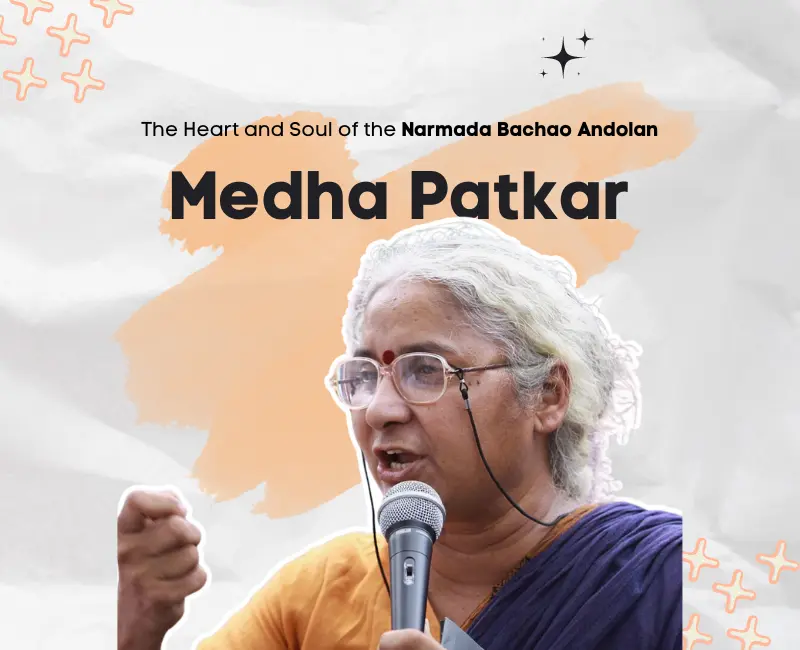Medha Patkar: The Heart and Soul of the Narmada Bachao Andolan

Medha Patkar, a name synonymous with social activism in India, has spent over five decades fighting for the rights of the marginalized. Born in 1954, Patkar’s journey began with a deep commitment to social work, earning a Master’s degree from the prestigious Tata Institute of Social Sciences. This academic foundation fueled her passion for social justice, leading her to become a powerful voice for those most vulnerable to the forces of development and displacement.
The Narmada Bachao Andolan: A Defining Struggle
Patkar’s most prominent role has been as the leader of the Narmada Bachao Andolan (NBA), the Narmada Bachao Movement. Founded in the late 1980s, the NBA emerged in response to the Sardar Sarovar Dam project on the Narmada river, one of India’s largest westward flowing rivers. The project, envisioned as a solution to water scarcity and power generation, promised significant economic benefits. However, the NBA raised concerns about the environmental and social costs. The dam’s construction threatened to displace thousands of indigenous communities, submerge vast tracts of fertile land and forests, and disrupt the delicate ecological balance of the Narmada Valley.
Patkar, along with other activists, led a long and arduous struggle. The NBA employed peaceful protests, hunger strikes, and legal challenges to highlight the plight of those affected. Patkar’s leadership style was characterized by her unwavering commitment to non-violent resistance. She became a symbol of hope for the displaced communities, leading large-scale marches and demonstrations that garnered national and international attention.
The Narmada Bachao Andolan’s impact transcended the immediate issue of the dam. It became a powerful critique of development models that prioritized economic benefits over the rights and livelihoods of marginalized communities. The movement’s success in raising public awareness and influencing policy discussions on displacement and environmental protection earned Patkar the prestigious Goldman Environmental Prize in 1999.
Beyond the Narmada: A Broader Vision for Social Justice
Patkar’s activism extends beyond the Narmada Valley. She is a founding member of the National Alliance of People’s Movements (NAPM), an umbrella organization representing hundreds of progressive social movements across India. Through the NAPM, Patkar has championed the causes of various communities facing social and economic injustice, including tribals, Dalits, farmers, and women. She has consistently advocated for policies that ensure equitable distribution of resources, land rights for indigenous communities, and the protection of the environment.
Criticisms and Controversies
Patkar’s unwavering commitment to her causes has also attracted criticism. Some argue that her stance against development projects hinders economic progress. Others have questioned the effectiveness of her methods, particularly the prolonged nature of protests that can disrupt daily life. A recent defamation case filed against her by Delhi’s Lieutenant Governor highlights the complexities of her activism.
A Legacy of Resilience and Inspiration
Despite the criticisms, Medha Patkar’s dedication to social justice remains an inspiration for many. Her life and work offer valuable lessons about the importance of raising one’s voice against injustice, even when the odds seem insurmountable. She has shown the power of non-violent resistance in holding the powerful accountable and advocating for the most vulnerable members of society.
Looking Ahead: The Future of Activism in India
As India grapples with issues of rapid development, environmental degradation, and social inequality, Patkar’s legacy serves as a crucial reminder of the need for a more inclusive and sustainable development model. The questions she raises about displacement, environmental protection, and the rights of marginalized communities remain relevant. Whether through the Narmada Bachao Andolan or the broader platform of the NAPM, Patkar’s influence continues to shape the landscape of social activism in India.
The Narmada Bachao Andolan: A Deeper Look
The Narmada Bachao Andolan (NBA) deserves a closer examination to understand the nuances of Patkar’s leadership and the movement’s impact. The project’s sheer scale – encompassing 30 large, 135 medium, and over 3000 small dams – threatened the displacement of an estimated 250,000 people, primarily belonging to indigenous communities heavily reliant on the river and surrounding forests for their livelihoods.
Beyond Displacement: Environmental Concerns
The NBA’s concerns went beyond the immediate displacement of communities. The submergence of vast tracts of land would have significant ecological consequences. The Narmada Valley boasts rich biodiversity with several endemic species. The dam’s construction threatened to disrupt natural water flow patterns and siltation, impacting downstream ecosystems and agricultural productivity. The movement raised concerns about the project’s long-term sustainability, questioning the viability of irrigated agriculture in a region prone to droughts.
Challenging the Development Narrative
The Narmada Bachao Andolan’s core critique focused on the dominant development narrative. The project, championed by the government and international funding agencies, prioritized economic benefits like irrigation and power generation. The NBA argued for alternative development models that considered the social and environmental costs. The movement advocated for decentralized, sustainable solutions like rainwater harvesting and micro-irrigation projects that could empower local communities and minimize ecological damage.
Strategies of Resistance: From Satyagraha to Public Discourse
Patkar’s leadership in the NBA was characterized by her unwavering commitment to non-violent resistance, or Satyagraha. The movement organized large-scale public demonstrations, marches, and rallies to raise awareness and garner public support. Patkar herself employed hunger strikes as a powerful tool for protest, drawing national and international attention to the plight of the affected communities.
The NBA also actively engaged in legal battles, challenging the project’s environmental clearances and resettlement policies in court. This multi-pronged approach, combining public mobilization, legal action, and media advocacy, played a crucial role in putting pressure on the government and forcing them to address the concerns of the affected communities.
Impact and Outcomes
The Narmada Bachao Andolan’s impact has been multifaceted. While the movement couldn’t completely halt the Sardar Sarovar Dam project, it did achieve significant concessions from the government. Resettlement and rehabilitation packages were improved, and independent oversight mechanisms were established to monitor the project’s environmental impact.
More importantly, the NBA set a precedent for future development projects in India. The movement’s success in highlighting the social and environmental costs of development forced policymakers to adopt a more inclusive approach, considering the rights and needs of marginalized communities. The Narmada Bachao Andolan’s legacy lies not just in its specific achievements but also in the broader conversation it sparked about sustainable development practices.
Medha Patkar: Beyond the Narmada
Patkar’s activism extends far beyond the Narmada Valley. She is a central figure in the National Alliance of People’s Movements (NAPM), a platform for hundreds of social movements across India. Through the NAPM, she has championed the causes of various marginalized communities facing issues like:
- Land Rights for Indigenous Communities: Patkar has consistently advocated for the recognition of land rights for Adivasi (indigenous) communities. These communities have faced historical dispossession and marginalization, and the NAPM works to secure their ancestral land rights and protect their traditional way of life.
- Struggles of Farmers: India’s agricultural sector faces numerous challenges, including rising input costs, inadequate irrigation facilities, and volatile market prices. The NAPM works to support farmers’ movements demanding fair prices for their produce, loan waivers, and better access to essential resources.
- Women’s Rights: Patkar recognizes the intersectionality of social justice issues. The NAPM actively works to empower women in rural communities, advocating for their education, economic opportunities, and participation in decision-making processes.
Criticisms and Controversies
Despite her significant contributions, Patkar’s activism has not been without its critics. Some argue that her unwavering opposition to large-scale development projects hinders economic progress, particularly in a country grappling with poverty and infrastructure deficiencies. They contend that the economic benefits of projects like the Sardar Sarovar Dam outweigh the social and environmental costs.
Others question the effectiveness of her methods, particularly the prolonged nature of protests that can disrupt daily life and livelihoods. Additionally, a recent defamation case filed against her by Delhi’s Lieutenant Governor highlights the complexities of her activism and the challenges faced by social movements in navigating legal battles.
Medha Patkar: A Symbol of Hope in a Complex World
Medha Patkar’s story transcends the specifics of the Narmada Bachao Andolan or the NAPM’s diverse struggles. She embodies a spirit of resistance against powerful forces, a commitment to non-violent methods for social change, and a vision for a more just and equitable world. Here’s a deeper exploration of her enduring legacy:
A Voice for the Voiceless: Patkar’s leadership has empowered marginalized communities to speak truth to power. By providing them with a platform and amplifying their voices, she has challenged the status quo and forced policymakers to acknowledge the concerns of those often ignored in development narratives. The Narmada Bachao Andolan, for instance, gave a voice to the Adivasi communities whose traditional way of life was threatened by the dam project.
The Power of Non-Violent Resistance: In a world often dominated by violence and conflict, Patkar’s unwavering commitment to Satyagraha stands as a powerful message. Her hunger strikes and peaceful protests demonstrate the effectiveness of non-violent resistance in achieving social change. This approach inspires others to engage in activism without resorting to violence or destruction.
A Catalyst for Change: Patkar’s activism has not just highlighted problems; it has also acted as a catalyst for positive change. The Narmada Bachao Andolan’s success in influencing resettlement policies and environmental considerations has set a precedent for future development projects. Similarly, the NAPM’s work on land rights, farmer issues, and women’s empowerment has pushed policymakers to address these critical issues.
A Spark for Global Conversations: Patkar’s activism resonates beyond India’s borders. Her struggles against displacement and environmental degradation find parallels in social movements worldwide. The Narmada Bachao Andolan’s story has contributed to global discussions on sustainable development practices, the rights of indigenous communities, and the ethical considerations of large-scale infrastructure projects.
Challenges and the Way Forward: The future of social activism in India, and globally, faces significant challenges. The rise of populism, the increasing power of corporations, and the complexities of the globalized world present new obstacles for those fighting for social justice. However, Patkar’s life and work offer valuable lessons for navigating these challenges.
Building Solidarity: Building broad-based coalitions across social movements, forging alliances with environmental groups, and engaging with international networks are crucial for amplifying voices and achieving lasting change.
Innovation and Adaptability: Social movements must be adaptable and willing to innovate their strategies. Utilizing social media, engaging with the media landscape creatively, and exploring new forms of protest can broaden reach and impact.
Building Sustainable Alternatives: Simply opposing development is not enough. Social movements like the NAPM need to actively propose and advocate for sustainable alternatives to the dominant development models. This could involve promoting renewable energy sources, decentralized solutions for water management, and fostering community-driven development initiatives.
Conclusion
Medha Patkar’s legacy is not just about her achievements but also about the questions she raises and the path she has paved for future generations of activists. In a world grappling with social inequality, environmental degradation, and the challenges of rapid development, her unwavering commitment to justice serves as a powerful inspiration. The fight for a more just and equitable world continues, and Medha Patkar’s story serves as a beacon of hope, urging us to raise our voices and work towards a better future for all.


